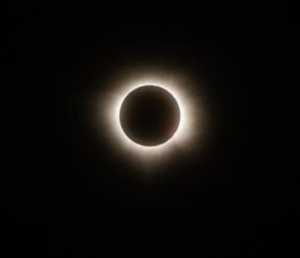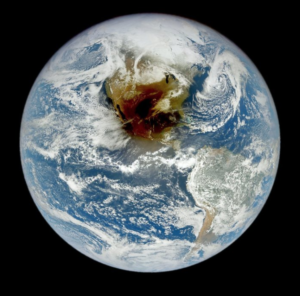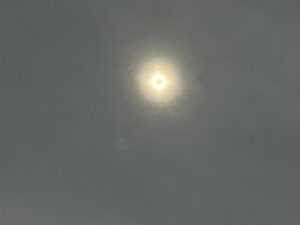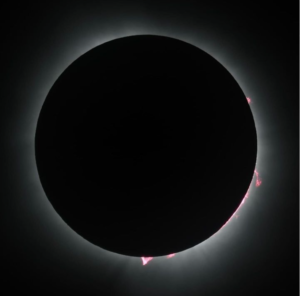Most of the time, we can comfortably live as though we are at the center of the universe. This month’s eclipse was a vivid reminder that we are not: that the universe is far larger, stranger, and more wonderful than our day-to-day experience may lead us to believe.
A solar eclipse happens whenever the moon passes between the earth and the sun, so that the moon’s shadow falls on the earth. Eclipses are not unusual–one happens somewhere on the earth’s surface every 18 months. But before August 21, 2017, the last one visible in North America was in June 8, 1918. Wendy and I were in Bowling Green, Kentucky in 2017 for that eclipse. We learned then that the next eclipse visible here in the continental U.S. would be April 8, 2024, and immediately made plans to go. So, two weeks ago, Wendy, Anthony, and I were at a motel in Sandusky, Ohio in the center of the zone of totality–and it did not disappoint!
We watched through our viewers as the moon advanced across the sun’s disk, from a wee bite off the lower right edge until the moon’s disk entirely covered the sun. The sunlight faded until the world became twilit. All around us, the horizon looked like a sunrise.
The photo at the head of this blog is not ours: it comes from the New York Times, and was taken by professional photographer @meghandhaliwal. Our own photos do not capture such detail, and are not nearly equal to our memories:
During the four and a half minutes of totality, when we could look up with unprotected eyes, the sun was a dark black circle–like a hole in the sky. The corona was as bright as I remembered, a ring of brilliant white fire. We could see a single bright star in the sky: the planet Venus. At the bottom of the sun’s dark disk was a bright pinkish spot that we later learned was a prominence: a solar flare!
Eclipses are minor miracles. The earth is just far enough away from our sun, and our moon is just large enough and just far enough away from us, that the moon and the sun have about the same apparent size in the sky. This means that, from our perspective, the moon can entirely block the sun’s disk: a total eclipse.
Ancient people of course also experienced eclipses, and so it should be no surprise that these awesome events are described in Scripture. The King James Version of Revelation 6:12 reads,
And I beheld when he had opened the sixth seal, and, lo, there was a great earthquake; and the sun became black as sackcloth of hair, and the moon became as blood. . .
The “moon became as blood” describes another, more commonly observed event, when the moon passes into the shadow of the earth: a lunar eclipse.
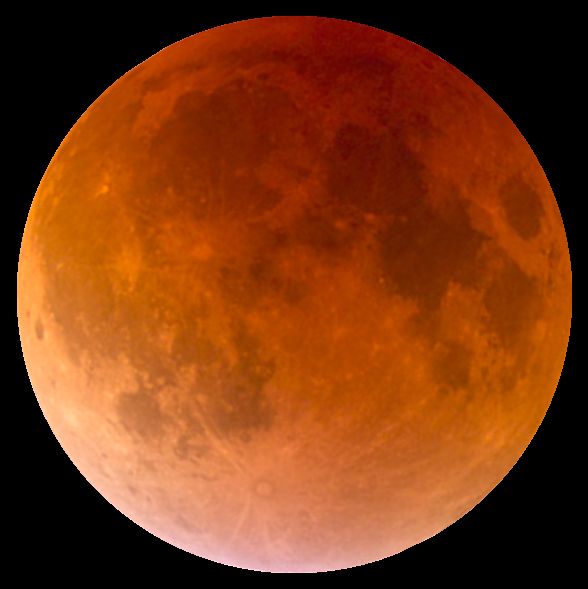
Although ancient people did not know what caused lunar and solar eclipses, they certainly knew that these events never happened in conjunction. So the sun becoming “black as sackcloth” and the moon becoming “as blood” could only mean an undoing of the fundamental laws of creation. John in Revelation draws on a stock of images of the coming day of the LORD, particularly Joel 2:30-31 (3:3-4 in Hebrew):
I will give signs in the heavens and on the earth—blood and fire and columns of smoke. The sun will be turned to darkness, and the moon to blood before the great and dreadful day of the LORD comes.
This image is also found in the Gospel pronouncements concerning the end:
In those days, after the suffering of that time, the sun will become dark, and the moon won’t give its light. The stars will fall from the sky, and the planets and other heavenly bodies will be shaken (Mark 13:24-25; see also Matt 24:29; Luke 21:25).
Another, surprising reference to the eclipse–and the title of this blog post!–comes from James 1:17:
Every good gift, every perfect gift, comes from above. These gifts come down from the Father, the creator of the heavenly lights, in whose character there is no change at all.
While the Common English Bible catches the sense of this passage, it obscures some subtleties in the language. First, the CEB unpacks the Greek phrase patros ton photon as “the Father, creator of the heavenly lights.” A more literal rendering of patros ton photon would be “the Father of lights” (see the NRSV and KJV of this verse). The reference is likely to Genesis 1:14-19, where God populates the sky dome with lights–both the greater lights of the sun and moon, and the lesser lights of the stars.
This astronomical image of God continues in the following phrase: par’ ho ouk eni parallage he tropes aposkiasma. Here, the CEB again paraphrases to capture the point of this image: God does not change, but is the constant and dependable source of “every good gift.”
But the KJV renders the Greek more literally, in a way that captures the astronomical reference: “with whom is no variableness, neither shadow of turning.” The stars change as the heavens turn above us. Indeed, the ancients knew well not only that the stars varied in brightness and color (see 1 Cor 15:31), but that some individual stars varied in brightness over time. They knew that sometimes new stars, as well as meteors and comets, could appear; and that the planets (from the Greek word for “wanderer”) followed from our perspective quite unique and distinct courses through the cosmos.
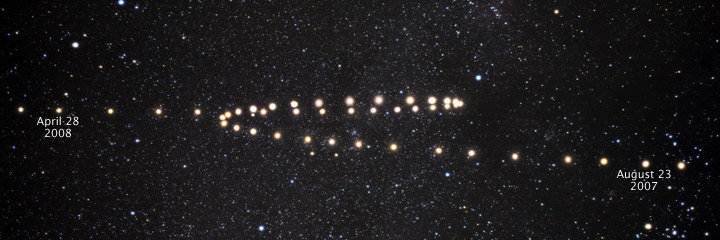
Unlike the heavenly lights, then, God their Father is constant! But the expression he tropes aposkiasma (literally, “nor of turning a shadow”) is particularly intriguing. I believe that it describes the eclipse.
The moon may wax, or wane, or turn blood-red, and the sun itself may dim, and even disappear–but God’s love and goodness cannot be eclipsed! As the apostle Paul wrote,
I’m convinced that nothing can separate us from God’s love in Christ Jesus our Lord: not death or life, not angels or rulers, not present things or future things, not powers or height or depth, or any other thing that is created (Rom 8:38-39).
AFTERWORD:
If you missed the joy and wonder of seeing the 2024 eclipse, your next chance in North America will be August 23, 2044, when an eclipse will be briefly visible from Montana, North Dakota and South Dakota–and I will be 88. However, the very next year (August 12, 2045), the path of totality will cut across the southern U.S., so maybe this old Bible Guy will see another eclipse after all!
